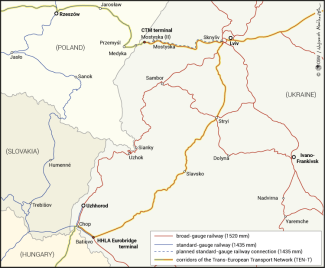Global shipping operator MSC is building bridgeheads in western Ukraine
The world’s largest container carrier – the Swiss–Italian company MSC – is gradually strengthening its position in Ukraine by taking control of the entire logistics chain. The company seeks to gain a competitive advantage over Denmark’s Maersk and France’s CMA CGM, both of which, like MSC, are gradually returning to the ports of the so-called Greater Odesa area (Odesa, Chornomorsk, and Pivdennyi). MSC is acquiring transshipment terminals in western Ukraine, and through its 2024 purchase of a 49.9% stake in the German company HHLA, it is positioned to achieve a dominant role in the Ukrainian market. HHLA operates terminals in, among other locations, the ports of Hamburg and Odesa, and owns Metrans, a leading intermodal transport operator in Central Europe. MSC’s ambitions are further supported by Ukraine’s ongoing transport integration with the European Union, including the construction of standard-gauge railway lines.
Ukraine’s transhipment infrastructure in wartime
Since the onset of Russia’s full-scale invasion of Ukraine, the development of transshipment infrastructure in the western part of the country has accelerated. This stems from the rerouting of freight flows to road and rail transport due to the periodic blockades of Ukrainian seaports, as well as from the relocation of industrial facilities from front-line areas to oblasts situated closer to the EU borders. It is also linked to investments in standard-gauge railway infrastructure along the Mostyska–Sknyliv section (from the Polish border to the vicinity of Lviv), for which the European Commission pledged €76 million in July 2025, and along the Uzhhorod–Chop section (near the Slovak and Hungarian borders), which was officially inaugurated on 8 September 2025.
Kyiv hopes that these investments will enable Ukraine to capture from neighbouring EU countries the added value generated by transshipment operations, forwarding, and transport services, which would bring substantial budgetary revenues and profits for domestic logistics enterprises – including the state-owned railway company Ukrzaliznytsia (UZ), which serves both as the railway infrastructure manager and as a passenger and freight carrier. Recent years have seen the emergence of new transshipment terminals in western Ukraine, particularly in the border regions. Demand has grown so strongly that a shortage of available land for the construction of additional terminals has become an increasing challenge for investors. These developments have not escaped the attention of the world’s largest shipping lines, particularly MSC – the global leader in the sector.
Since the spring of 2024, global shipping operators have gradually begun returning to the ports of the so-called Greater Odesa area. Nonetheless, Ukraine’s container market continues to be served primarily through foreign ports – notably Romania’s Constanța and Gdańsk in Poland. According to estimates, as much as 40% of cargo destined for Ukraine passes through Gdańsk’s Baltic Hub terminal.
Prior to the Russia’s full-scale invasion, Ukrainian ports handled a relatively small volume – just over 1 million TEU annually. Due to the temporary blockade of the so-called Greater Odesa ports, this figure dropped to only 65,000 TEU in 2023. However, forecasts suggest a rebound to approximately 320,000 TEU in 2025. MSC currently calls at the port of Odesa, where HHLA operates Ukraine’s largest container terminal – CTO (Container Terminal Odesa). CMA CGM also uses this port, while Maersk calls at Chornomorsk.
MSC’s ambitious strategy
The Ukrainian market may play a pioneering role in the new strategy pursued by global shipping operators to gain control over the entire logistics chain in Europe. These companies no longer limit themselves to providing maritime connections; they are increasingly capturing the added value previously generated by other actors through rail, road, transshipment, warehousing, forwarding, and customs agency services. MSC is gradually implementing this approach in Ukraine, as it seeks to strengthen its position in logistics services and in land transport between Ukraine and the European Union.
Recently, MSC has undertaken a series of key acquisitions of terminals in Ukraine. In May, its logistics subsidiary Medlog acquired from Ukrainian businessman Yehor Hrebennykov a 50% stake in the company N’UNIT, which operates intermodal terminals in Kharkiv, Dnipro, and Kyiv, as well as a 25% stake in the terminal at Mostyska (Container Terminal Mostyska, CTM), located near the Polish border (50% of which remains owned by Lemtrans, a company linked to Ukrainian oligarch Rinat Akhmetov). CTM can serve as a transshipment hub, as it is equipped with both broad-gauge (1520 mm) and standard-gauge (1435 mm) railway tracks. The company has been expanding rapidly: between 2022 and 2024, its revenues increased from 97 million hryvnias (approximately $2.4 million) to 389 million hryvnias ($9.4 million). According to Forbes Ukraine, the transaction followed around a year of negotiations and is estimated to be worth between €15 and €30 million.
In June, the German logistics operator HHLA – which manages container terminals in ports such as Hamburg, Odesa, Tallinn, and Trieste, and in which MSC holds a 49.9% stake – submitted a bid to purchase a 60% stake in the Eurobridge Batiovo intermodal terminal, located near the borders with Hungary and Slovakia. On 7 August, the Antimonopoly Committee of Ukraine approved the transaction, paving the way for its finalisation in the near future. This terminal also has access to both broad-gauge and standard-gauge railway lines and will operate under a new name, HHLA Eurobridge Batiovo, as a joint venture between the German company and the Ukrainian investment company Fortior Capital. Although the terminal currently handles mainly bulk cargo, HHLA plans to launch container transshipment operations in the final quarter of 2025.
According to the company’s strategy, the Batiovo terminal is intended to handle freight flows towards Southern Europe (via Slovakia and Hungary), while the Mostyska terminal will serve routes to Western Europe (via Poland). The development of these terminals is to be supported by Metrans, an HHLA subsidiary that is already the largest intermodal operator in Central and Eastern Europe, owing to its extensive network of transshipment terminals in Austria, the Czech Republic, Germany, Poland, Romania, Serbia, and Slovakia. The company’s presence in the Ukrainian market will undoubtedly provide a significant boost to its further growth. As UZ continues to hold a monopoly on rail transport in Ukraine (and market liberalisation, a requirement for EU accession, will take many years to implement), Metrans is currently unable to operate rail services directly. Thus, in 2020 HHLA established a Ukrainian subsidiary – Ukraine Intermodal Company (UIC) – which manages freight transport, mainly from the CTO terminal in Odesa, in cooperation with UZ.
Outlook
Other shipping companies, such as Maersk and CMA CGM, have also significantly expanded their presence in Ukrainian intermodal terminals, making use of dry ports in Kharkiv, Chernihiv, Dnipro, Kyiv, Klevan, Mostyska, Ternopil, Vinnytsia, and Zaporizhzhia. Maersk had been encouraged to develop its operations in Ukraine and to become the operator of the container terminal in Chornomorsk – one of the largest in the country – by the then Deputy Prime Minister, now Prime Minister, Yuliia Svyrydenko. At present, however, neither the Danish nor the French shipping line has any capital involvement in terminals in Ukraine.
Growing interest from shipping operators and other global logistics players in investing in transhipment terminals in Ukraine can be expected. This trend is also linked to Kyiv’s ambitious plans for expanding border infrastructure. Notably, nearly half of the funds allocated under Ukraine’s Strategy for the Development and Expansion of Border Infrastructure with the EU and Moldova by 2030 (46.6 billion hryvnias, or approximately US$1.13 billion) are to be earmarked for infrastructure projects along the Polish border. These will include the modernisation and expansion of five road crossings (Yahodyn, Ustyluh, Rava-Ruska, Nyzhankovychi, and Shehyni) and two rail crossings (Yahodyn and Mostyska).
The partial relocation of transhipment operations further into Ukrainian territory should be regarded as a natural development accompanying the gradual eastward shift of the junction between standard- and broad-gauge railway lines. This process is driven by the competitive rates offered by Ukrainian terminals, the monopolistic position of UZ, and the growing presence of the world’s largest shipping companies in Ukraine’s intermodal terminals. However, it also entails a loss of potential profits for Polish terminal operators, as well as rail and road carriers, and in the longer term may pose a threat to the operations of the company PKP LHS.
Map. Rail infrastructure and selected transhipment terminals in western Ukraine

Source: author’s own research.





